Photo / Video News & Reviews
Nauticam Announce New Housing For The Sony A7 II
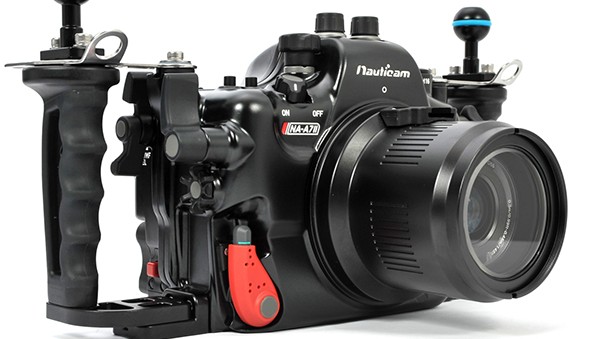
Nauticam have announced the NA-A7II, the newest entry in it’s mid-range series of underwater camera housings. The NA-A7II is an incremental improvement over the NA-A7 housing.
The new Sony A7II (officially called Sony Alpha 7 II) follows hot on the heals of the A7, adding some significant improvements, including a 5-axis sensor-shift image stabilization. The A7II, features a 24MP full-frame CMOS sensor, and focus is improved with a Hybrid AF system utilizing on-sensor phase-detect points. From a design perspective, other improvements in this model include more rugged build quality, a beefier grip, more and better laid out custom buttons, and a more ergonomically placed shutter release button. Other features include a 3-inch tilting LCD, XGA OLED electronic viewfinder, Multi-interface (hot) shoe, Wi-Fi with NFC, and 1080/60p video recording – now with XAVC S and a flat ‘S-Log2’ picture profile.
The A7II features the same full-frame 24MP CMOS sensor that was found on the original A7. It uses a hybrid autofocus system, which has 25 contrast detect and 117 phase detect points spread across its sensor. Sony engineers claim that autofocus performance has improved by 30% and tracking by 50% compared to the A7. Autofocus and now auto exposure can be used while tracking a moving subject during burst shooting (at 5 fps).

Shot with Sony A7II using FE 16-35mm lens. 1/125 at f/7.1 ISO 200. Zen DP-200 port.
Ergonomically, the A7II is improved over the A7, and the difference is obvious when picking up the camera. It feels more substantial in the hand, and the shutter button in particular is more comfortable. The grip is larger and significantly more substantial which keeps the hand in a more relaxed position when gripping the camera. The A7II uses more magnesium alloy and less plastic than the A7, allowing the overall build quality to seem more solid with only a minor increase in weight.
Like previous models, the A7II supports WiFi, NFC, and a number of apps making sharing very easy, while opening up the camera’s capabilities.

The NA-A7II Housing
The NA-A7II looks quite similar to the NA-A7, and the housings are approximately the same dimensions. The NA-A7II ships with built-in, yet adjustable handles, featuring Nauticam’s contoured rubberized grip. The “AF/MF/AEL” button is given special treatment on the right side of the housing with a direct access lever immediately reachable by the right thumb. This allows the button to be programmed for AF-ON meaning easy functionality for “thumb focus” fans. The shutter release can be accessed at the same time, offering quick focus-to-shoot finger action. Like many Nauticam housings, the play button is brought up to the left thumb, and the three command dials (think shutter speed, aperture and exposure compensation) can be adjusted quickly with minimal reach. The ISO button is within short reach of the right thumb, important for video shooters. Speaking of video, the record button is on the top right, thus eliminating camera shake during video start/stop.

The Function Menu button opens up common camera settings to a quick menu, and this button is a short reach with the right thumb. The programmable C3 button is a very easy reach and can be programmed for any of several functions. The housing features a switch to change between the EVF and the LCD providing rapid and secure transition between viewing modes, and supports Nauticam’s viewfinders.
Installing a lens with a gear attached is made easy by the new pull-out zoom/focus dial.
A Nauticam Mini Flash Trigger made specifically for Sony is an available option, allowing the camera to shoot rapid fire with flood free optical cables. The housing includes an M16 bulkhead port for optional HDMI out, Nikonos style sync cable or other external accessory.
The NA-A7II accommodates for the larger than expected grip of the camera. Nauticam say that rather than compromise on image quality, their designers chose to create ports than take into account this difference, hence a separate entry in the port chart for this housing.

Lens Matters
The original A7 and A7R cameras from Sony sparked a huge interest in going full frame for mirrorless. For the underwater photographer, this enthusiasm was quickly diminished by the fairly limited lens selection. Underwater image makers rely on very wide angle lenses and macro lenses, and they were nowhere to be found.

However, the recently released 16-35mm is a game changer. This is a lens from the Sony Zeiss partnership, quaintly dubbed the Sony Vario-Tessar T* FE 16-35mm F4 ZA OSS. It’s a rectilinear wide angle zoom that focuses close and demonstrates very good sharpness all around with medium to large sized dome ports. The Nauticam 180mm dome is an ideal choice for this lens.
For macro lovers, Sony recently announced a 90mm macro beauty (Sony FE 90mm f/2.8 Macro G OSS), and this lens will be supported as soon as possible after it is shipped (slated for July). Also just announced is a new 28mm f/2 lens with a fisheye adapter, similar to what Sony did with the fisheye and wide angle adapter on the 16mm lens for the NEX series. This is an appealing way to get fisheye, as it allows multiple configurations with a single lens. Look for more info about Nauticam support for this lens when it ships (slated for May).
Owners of Canon full frame lenses like the EF 8-15mm f/4L Fisheye USM, EF 100mm f/2.8L Macro IS USM, or the EF 16-35mm f/2.8L II USM lenses will apreciate the ability to use these fine optics with the A7 series. This is made possible with a Metabones adapter (Canon EF Lens to Sony NEX Smart Adapter (Mark III or Mark IV)). These lenses work well on the A7 series, providing both aperture and autofocus control from the camera.
NA-A7II set up with the Nauticam 180mm dome for the Sony Vario-Tessar T* FE 16-35mm F4 ZA OSS, with manual focus and zoom controls.
Speaking of Lenses
Nikonos “water contact” lenses are the stuff of legend, but too many of them are sitting in a box in a closet. Time to dust them off! The full frame A7II is a great way to bring those lenses back to action. With the full frame sensor, this Sea&Sea 12mm or the famous Nikonos 15mm behave like they were intended to.

Standard 0.66x viewfinder, standard on NA-A7II.
Viewfinder Options
The NA-A7II ships with a standard 0.66x viewfinder. This standard optical glass viewfinder is travel friendly and suitable for image makers that care to use the LCD for most framing. Many photographers prefer the ease of a magnified viewfinder with adjustable diopter to take advantage of the EVF in this camera.

Nauticam 180º Enhanced Viewfinder Installed on NA-A7II.
Nauticam produces a “straight” 180º enlarging viewfinder and a 45º angled enlarging viewfinder to enhance the ease of close quarters work often associated with macro shooting. Both viewfinders have high quality optics, and allow bright viewing of the entire image. A patented external dioptric adjustment allows personal adjustment to a sharp-as-a-tack standard underwater and viewfinder changes can be executed in less than 30 seconds without using tools. Exceptional composition and focus accuracy have never been more accessible.

Nauticam 45º Enhanced Viewfinder Installed on NA-A7II.
NA-A7II Feature Checklist
- Ergonomically placed controls with size, shape, and color differentiation
- Access to all key camera controls
- All controls clearly labeled
- Patented two stage shutter release system, allowing precise feel over half press and full press
- Patented Port Locking System
- Patent pending Multi Controller pad
- Lens release button
- Easy to operate locking housing latches
- Rubberized ergonomic grips on adjustable handles
- Laser-cut steel handle brackets
- Quick release camera mounting plate
- Optical strobe connectors for fiber optic flash triggering
- Mini Flash Trigger
- M16 accessory hole for electrical bulkhead, HDMI or hydrophone installation
- M14 accessory hole for vacuum valve installation
- Integrated vacuum monitoring and leak detection circuit (valve optional)
- Dual 1″ (25mm) strobe mounting balls included as standard equipment
- 1/4-20 tripod mounting holes
- Dual M5/M10 threaded accessory mounting points
- 100m Depth Rating

Integrated Vacuum Check and Leak Detection System
The Nauticam vacuum check and leak detection system is available with NA-A7II as standard equipment. Combined with an optional vacuum valve, this monitoring system provides constant updates on the water tight and safe to dive status of the housing. A simple coded LED lighting system lets the user know that the vacuum is solid, or that the housing is losing vacuum. Leak detection is built into the same circuit, so if there is water intrusion, an audible and visual indication will occur. The housing ships with a rear bulkhead port specifically for installing optional vacuum valves, leaving the other bulkhead port available for HDMI, sync cables and other accessories.

Recommended Accessories
- 180º Enhancing Viewfinder (32201)
- 45º Enhancing Viewfinder (32203)
- Mini Optical Flash Trigger (26302)
- Patent Pending Super Macro Converter (81201)
- M14 Vacuum Valve (25611)
- Complete line of flat/dome ports for all major lenses, available in acrylic and glass
- Monitor/Recorder Housing for Atomos Ninja2 (17902)
- Monitor Housing for SmallHD DP4 Monitor (17901)
- Fiber optic cables for Inon (26211) and Sea&Sea (26212)
- Full line of mounting accessories for lighting, including mount balls, strobe adapters, arms, clamps, and specialty items
- Multiple styles of lanyards
- Lens holders, including flip-up
Details and Specifications
- Depth Rating: 100m
- Weight: 2.35 kg (with handles & 1″ ball adaptors mounted)
- Dimensions (with handles mounted): 335 (W) x 165 (H) x 110 (D)
Model Number (w/ Nikonos Bulkhead): 17414
USA Retail Price: $2850
Model Number (no Bulkhead): 17414NB
USA Retail Price: $2750
Shipping: Now
More information is available from Nauticam USA at: www.nauticamusa.com
Blogs
Diver Discovering Whale Skeletons Beneath Ice Judged World’s Best Underwater Photograph
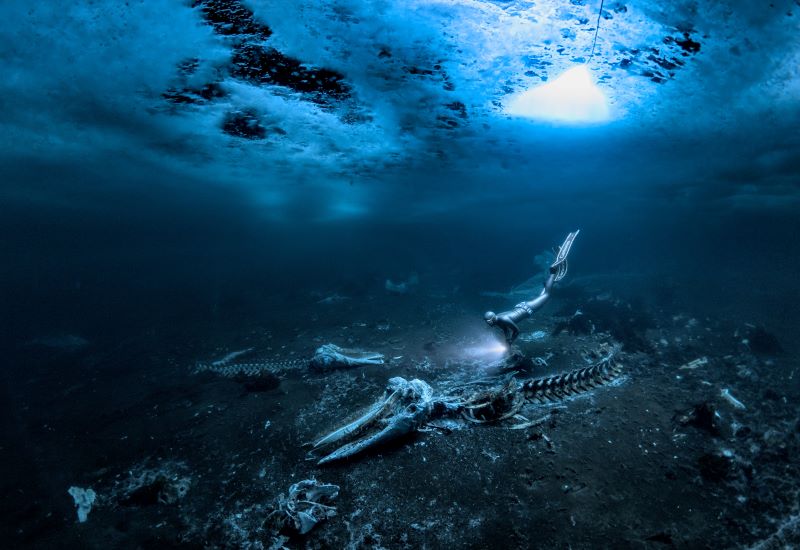
An emotive photograph showing a freediver examining the aftermath of whaling sees
Alex Dawson from Sweden named Underwater Photographer of the Year 2024. Dawson’s
photograph ‘Whale Bones’ triumphed over 6500 underwater pictures entered by underwater
photographers from around the world.
“Whale Bones was photographed in the toughest conditions,” explains chair of judging
panel Alex Mustard, “as a breath-hold diver descends below the Greenland ice sheet to bear
witness to the carcasses. The composition invites us to consider our impact on the great
creatures of this planet. Since the rise of humans, wild animals have declined by 85%. Today,
just 4% of mammals are wildlife, the remaining 96% are humans and our livestock. Our way
needs to change to find a balance with nature.”
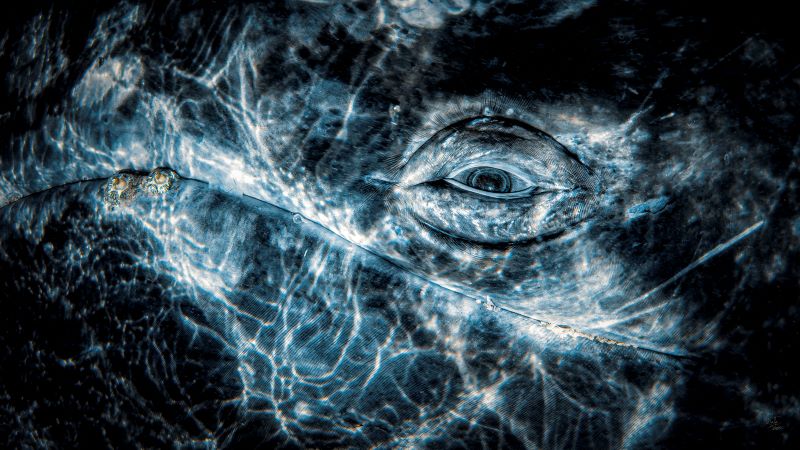
Photo: Rafael
Fernandez Caballero
Whales dominated the winning pictures this year with Spanish photographer Rafael
Fernandez Caballero winning two categories with his revealing photos of these ocean giants:
a close up of a grey whale’s eye and an action shot of a Bryde’s whale engulfing an entire bait
ball, both taken in Magdalena Bay, Baja California, Mexico. Fernandez Caballero took ‘Grey
Whale Connection’ while drifting in a small boat, holding his camera over the side in the water
to photograph the curious whale. ‘The End Of A Baitball’ required Fernandez Caballero to dive
down and be in exactly the right place at the moment the whale lunged. “The photo shows
the high speed attack,” he said, “with the whale engulfing hundreds of kilograms of sardines
in one bite — simply unforgettable to see predation on such a scale.”
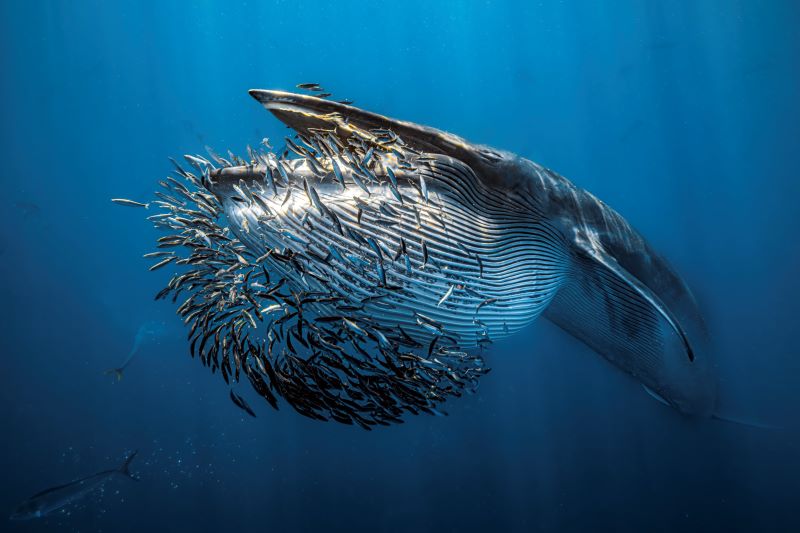
Photo: Rafael
Fernandez Caballero
Lisa Stengel from the United States was named Up & Coming Underwater Photographer of the Year 2024 for her image of a mahi-mahi catching a sardine, in Mexico. Stengel used both a very fast shutter speed and her hearing to catch the moment. “If you listen there’s an enormous amount of sound in the ocean,” she explained. “The action was too fast to see, so I honed in on the sound of the attacks with my camera to capture this special moment.”
“It is such an exciting time in underwater photography because photographers are capturing such amazing new images, by visiting new locations and using the latest cameras,”
commented judge Alex Mustard. “Until this year I’d hardly ever see a photo of a mahi mahi,
now Lisa has photographed one hunting, action that plays out in the blink of an eye.”
The Underwater Photographer of the Year contest is based in the UK, and Jenny Stock,
was named as British Underwater Photographer of the Year 2024 for her image “Star
Attraction”, which finds beauty in species of British wildlife that are often overlooked.
Exploring the west coast of Scotland, Stock explained “in the dark green depths my torch
picked out the vivid colours of a living carpet of thousands of brittle stars, each with a
different pattern. I was happily snapping away, when I spotted this purple sea urchin and I
got really excited.”
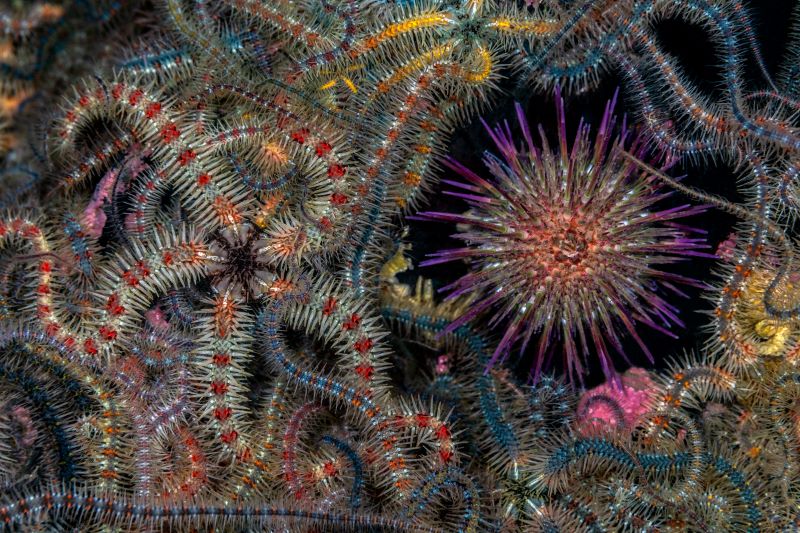
Photo: Jenny Stock
In the same contest, Portuguese photographer, Nuno Sá, was named ‘Save Our Seas
Foundation’ Marine Conservation Photographer of the Year 2024, with his photo ‘Saving
Goliath’, taken in Portugal. Sá’s photo shows beachgoers trying to save a stranded sperm
whale. The picture gives us hope that people do care and want to help the oceans, but also
warns us that bigger changes are needed. “The whale had been struck by a ship and its fate
was sealed,” explains Sá. “An estimated 20,000 whales are killed every year, and many more
injured, after being struck by ships-and few people even realise that it happens.”
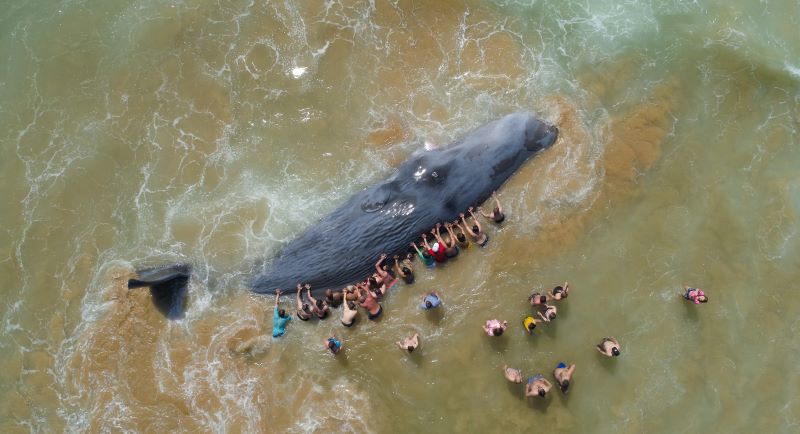
Photo: Nuno Sá
More winning images can be found at www.underwaterphotographeroftheyear.com.
About Underwater Photographer of the Year
Underwater Photographer of the Year is an annual competition, based in the UK, that celebrates photography beneath the surface of the ocean, lakes, rivers and even swimming pools, and attracts entries from all around the world. The contest has 13 categories, testing photographers with themes such as Macro, Wide Angle, Behaviour and Wreck photography, as well as four categories for photos taken specifically in British waters. The winners were announced in an award ceremony in Mayfair, London, hosted by The Crown Estate. This year’s UPY judges were experienced underwater photographers Peter Rowlands, Tobias Friedrich and Dr Alexander Mustard MBE.
Header image: Underwater Photographer of the Year 2024 winner Alex Dawson
News
World’s Best Underwater Photographers Unveil Breathtaking Images at World Shootout 2023
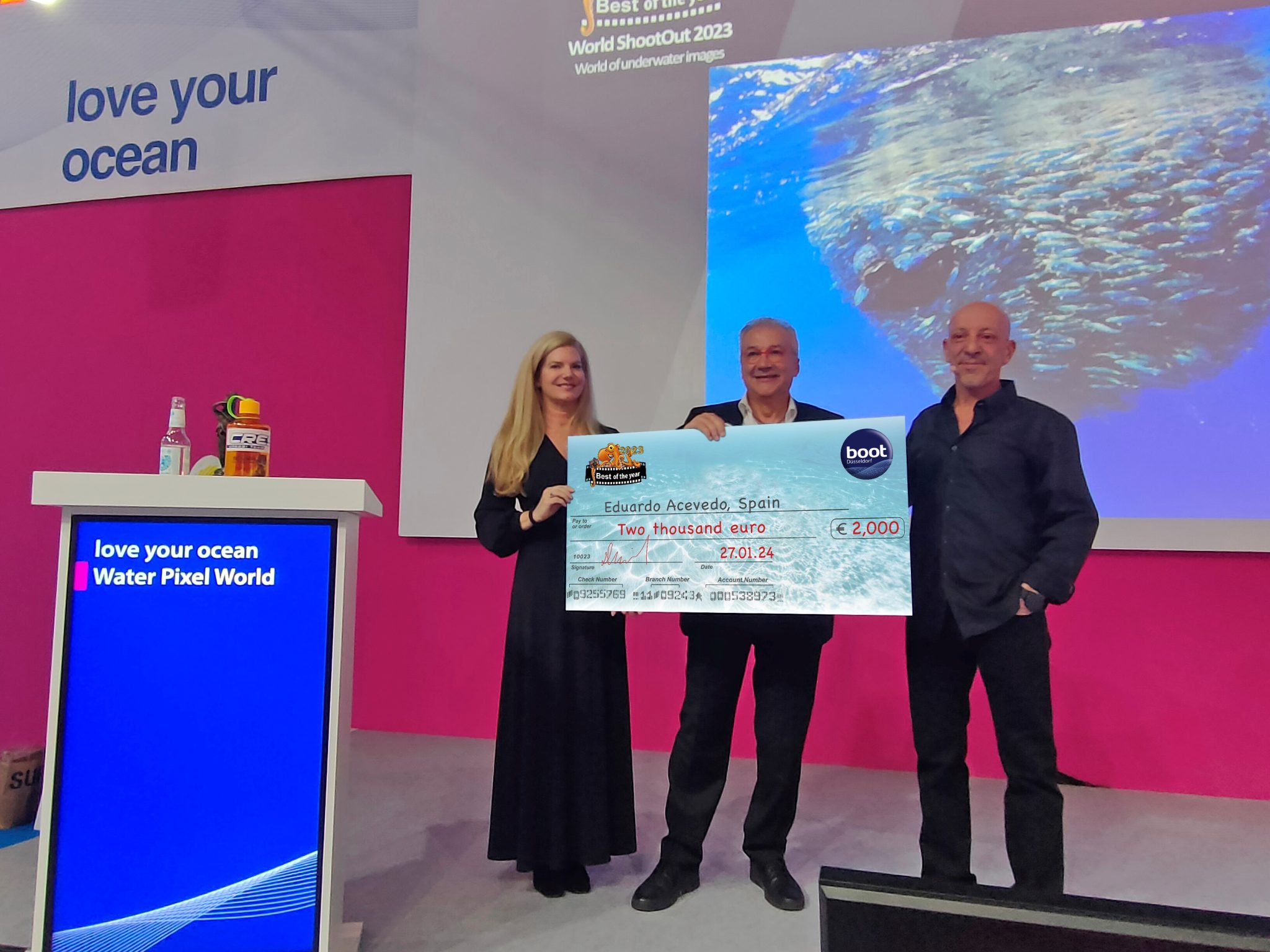
The winners of the prestigious World Shootout 2023 underwater photography competition were announced at this year’s BOOT Show, captivating audiences at the world’s largest diving and water sports exhibition in Dusseldorf, Germany. Hundreds of photographers from 54 countries competed across nine categories, pushing the boundaries of creativity and technical skill.
Grand Prize Winners
- Picture of the Year: Spanish photographer Eduardo Acevedo “secured” the top Honor with the prestigious prize the “boot Dusseldorf Director’s Prize, earning an Andromeda statuette and a €2,000 cash prize.
- Best 5 Images Portfolio: Luc Rooman from Belgium triumphed in this category, winning a dream 4-week diving trip for two to Papua New Guinea, valued at $18,900.
- Amateur Photographer: Alexandra Ceurvorst from the USA impressed the judges with her talent, taking home the 1,000 € cash prize award.
Celebrating Diversity and Innovation
This year’s competition saw 11,680 entries from 964 photographers, showcasing a remarkable spectrum of skills and perspectives. From the intricate wonders of Macro photography to the beauty of “Black Water”, the “Underwater Fashion” category added a touch of artistry and innovation, while the ever-important ” Environmental & Conservation” category served as a powerful reminder of the need to protect these fragile ecosystems.
Looking Ahead: AI and Ocean Conservation
World Shootout founder and producer David Pilosof unveiled an exciting addition for the 2024 competition: this year the Environmental category will be focusing on the impact of plastic on our oceans and future.
This category will embrace the potential of AI or other editing software as a tool to amplify the conservation message.
Entrants will submit campaigns of three original underwater photographs dealing with plastic pollution, along with their final AI assistance processing. This innovative approach encourages artistic expression while raising awareness about a critical environmental issue.
Explore the Stunning Collection
Discover the complete album of competition entries by clicking here.
For Low-resolution photos of finalist entries in eight categories, click here.
-

 News3 months ago
News3 months agoHone your underwater photography skills with Alphamarine Photography at Red Sea Diving Safari in March
-

 News3 months ago
News3 months agoCapturing Critters in Lembeh Underwater Photography Workshop 2024: Event Roundup
-

 Marine Life & Conservation Blogs3 months ago
Marine Life & Conservation Blogs3 months agoCreature Feature: Swell Sharks
-

 Blogs2 months ago
Blogs2 months agoMurex Resorts: Passport to Paradise!
-

 Blogs2 months ago
Blogs2 months agoDiver Discovering Whale Skeletons Beneath Ice Judged World’s Best Underwater Photograph
-

 Gear Reviews2 weeks ago
Gear Reviews2 weeks agoGEAR REVIEW – Revolutionising Diving Comfort: The Sharkskin T2 Chillproof Suit
-

 Marine Life & Conservation2 months ago
Marine Life & Conservation2 months agoSave the Manatee Club launches brand new webcams at Silver Springs State Park, Florida
-

 Gear Reviews3 months ago
Gear Reviews3 months agoGear Review: Oceanic+ Dive Housing for iPhone






